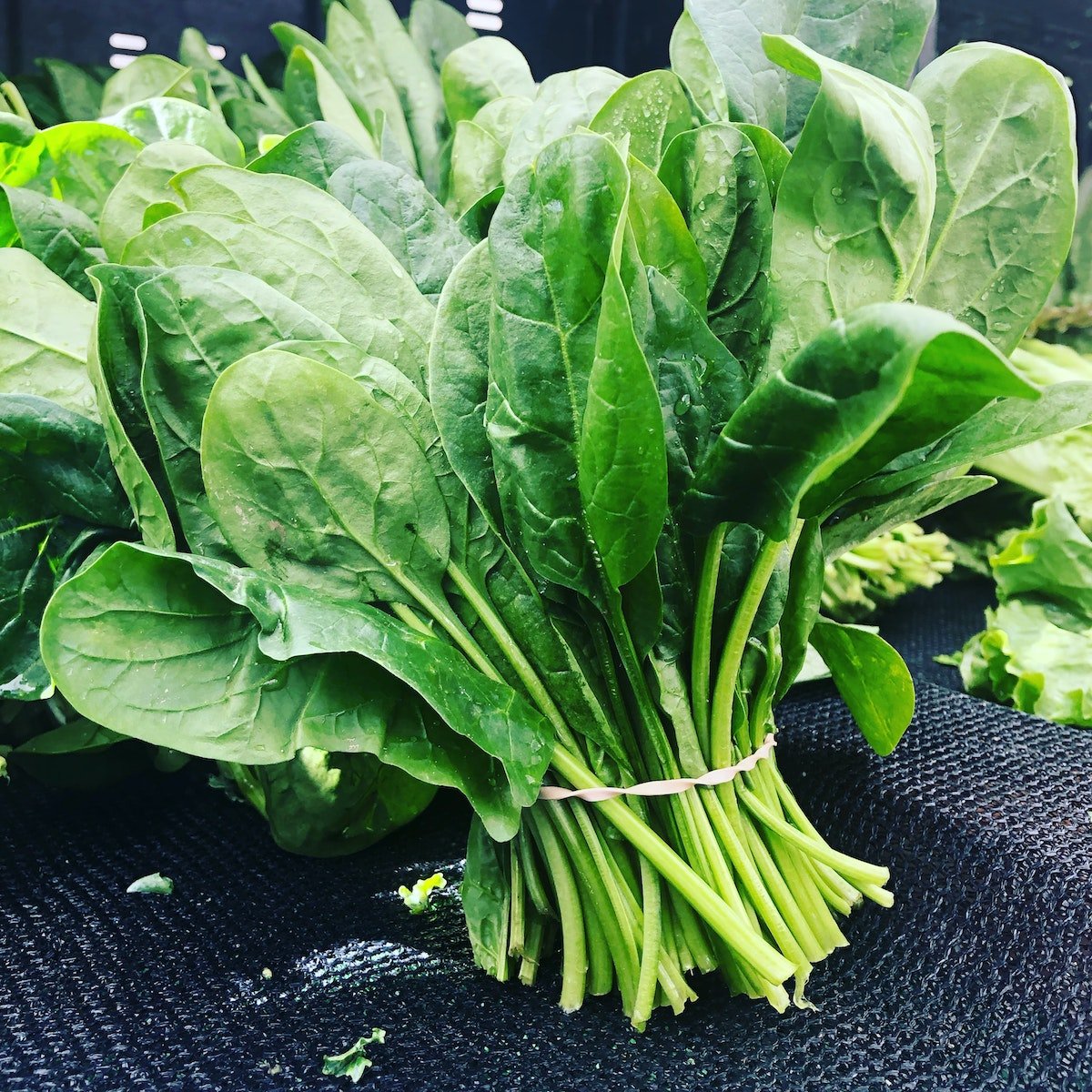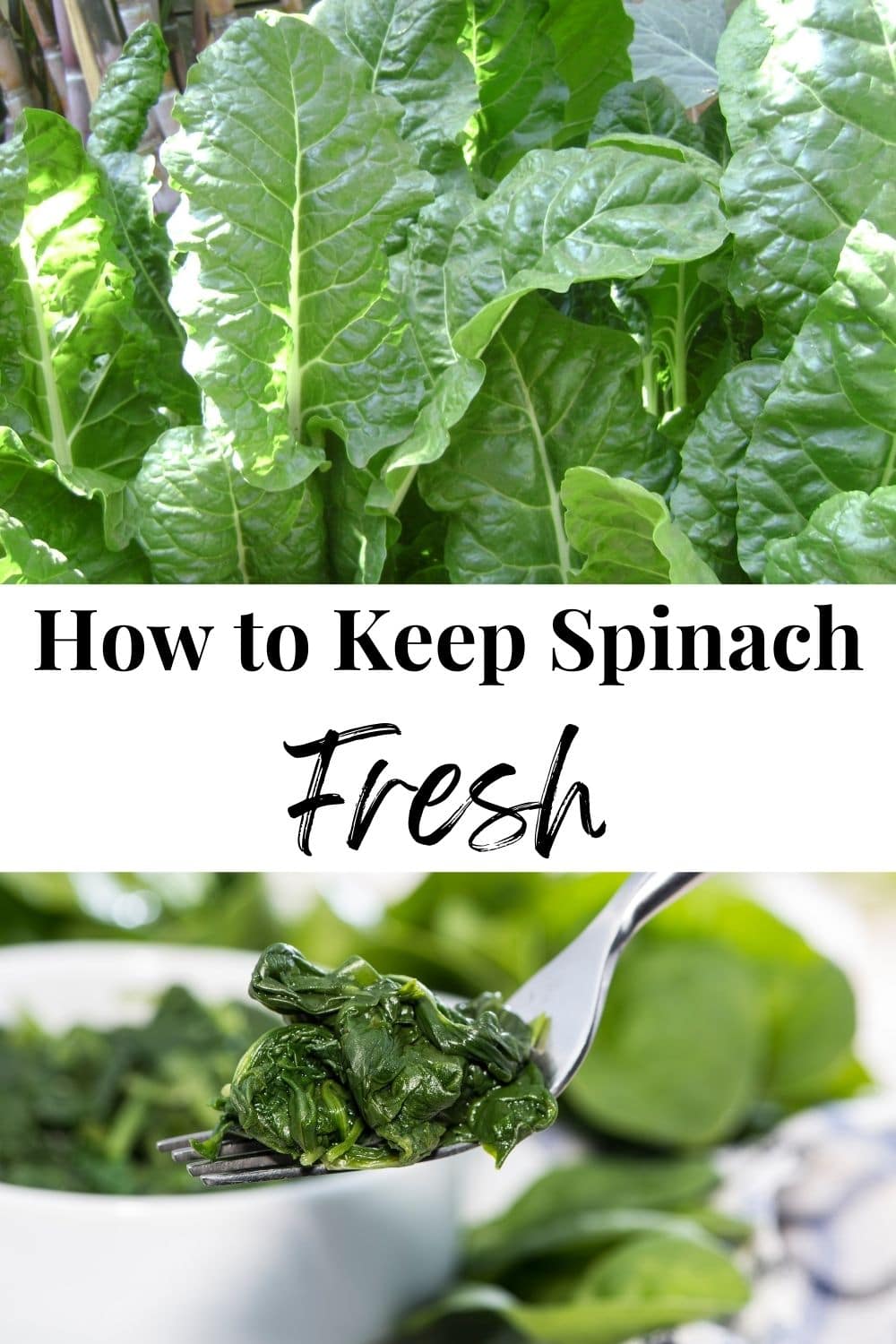How long does spinach last? Here are the best tips for storing fresh and cooked spinach to taste the best and last the longest possible!

Jump to:
- How Long Does Fresh Spinach Last?
- Storage Tips to Make Fresh Spinach Last Longer
- Can You Freeze Fresh Spinach?
- Is Raw Spinach Safe to Eat?
- How Do You Know If Spinach Has Gone Bad?
- How Long Does Cooked Spinach Last?
- Storage Tips to Make Cooked Spinach Last Longer
- Who Should Not Eat Spinach?
- The Bottom Line
Whether you grow spinach in your garden or buy it from a local farmer’s market or grocery store, this is a leafy green that can spoil quickly if you’re not careful.
I’ve included the best storage tips to keep your fresh and cooked spinach fresher longer so that you can enjoy your harvest (whether it’s from the ground or the grocery store) with less food waste.
So, if it seems that you watch your spinach go bad in the back of your refrigerator, take some notes to keep spinach fresh, safe, and out of the trash!
How Long Does Fresh Spinach Last?
The shelf life of spinach is typically 5-7 days but can be as long as 14 days if it’s stored the right way.
Consider where you’re getting your spinach from. If it's being shipped from across the country, it has likely already had several days to begin the spoiling process.
If you’re able to get your hands on fresh spinach the day it is harvested, it can stay fresh for up to two weeks.
When buying bagged spinach or spinach in a plastic container, you may notice that some condensation has built up on the inside of the container. If this happens, you want to make sure you remove the greens from the bag it came in and follow the storage tips below.
Storage Tips to Make Fresh Spinach Last Longer
Here are some steps to store spinach and keep it fresh for up to 10 days (maybe even longer!).
- Remove any loose debris or spoiled-looking leaves. Avoid washing before storing.
- Line an airtight container with a paper towel or tea towels and place the spinach inside. You want the environment to stay as dry as possible.
- Place the container in the crisper drawer or the coldest place in your refrigerator.
- Replace the paper towels or cloth every few days if it becomes moist.
Storing spinach without washing is best, as adding moisture will only increase the rate that it spoils. But, if you do want to wash it before storing it you’ll want to make sure the spinach is as dry as possible by following these tips.
- Wash the spinach leaves in cold water to carefully remove any dirt, bugs, debris, and chemical residue.
- Lay the leaves out on a kitchen towel and lightly blot with another towel to remove excess moisture. You can make the drying process faster by using a salad spinner first. You want the leaves to be as dry as possible before storing them.
- Line an airtight bag or container with a paper towel or thin tea towels and add the spinach.
- Check the next day (and every day or two after) for moisture and replace the towels as needed.
Can You Freeze Fresh Spinach?
Yes, you can freeze fresh spinach. This is a great way to preserve a large harvest, a few extra bunches that you bought on sale, or even just a small amount of leftover spinach that you don’t have an immediate use for.
As a bonus, when you freeze spinach, you preserve many of the nutrients that could otherwise be lost as it sits in the refrigerator.
There are a few ways to freeze spinach, based on how you want to use it after thawing.
- To use in smoothies: Freezing spinach is perfect for making green smoothies or just adding a little extra nutrition to any everyday smoothie.
Blend the spinach leaves with a small amount of water until you have a puree. Pour the puree into ice cube trays or a silicone muffin tin and freeze for 4-6 hours. After the puree is frozen, remove it from the tray and store it in the freezer in resealable plastic bags or an airtight container for up to 6 months.
If you store the spinach longer than 6 months, freezer burn is more likely to occur.
- To use in cooked dishes: If you’re planning to add your spinach to a cooked dish like soup, pasta, or a sauce, you’ll want to blanch your spinach before freezing. To do this, first wash the spinach well and bring water to a boil.
Once the water is boiling, add the spinach leaves for two minutes, then remove and place them in an ice-water bath to stop the cooking process. You can then portion the spinach leaves how you would like and freeze them in an airtight container.
Easy ways to portion the spinach leaves are by either scooping them into piles on a lined baking sheet, then freezing them before adding to a freezer-safe container or putting them into silicone muffin molds, freezing, then transferring.
When it comes time to use the frozen spinach, you can take what you need out of the freezer and add it straight to the dish while it’s cooking or thaw in the refrigerator beforehand.
Is Raw Spinach Safe to Eat?
Spinach leaves are notorious harborers of bacteria and have been the source of e.coli outbreaks in the past. The Centers for Disease Control (CDC) recommends taking some precautions when eating raw spinach, and other leafy green vegetables, to minimize the health risk and keep you and your family safe.
This includes washing all leafy greens under cold running water before eating or cutting them, using clean cutting boards and knives, discarding any spoiled pieces, and drying well before storage. The CDC also recommends keeping leafy greens in the refrigerator and not leaving them out at room temperature for longer than 2 hours.
How Do You Know If Spinach Has Gone Bad?
The best way to tell if spinach is bad is to use your senses. If these signs of rotting or decaying leaves are present, avoid eating the leaves as they could contain bacteria that can make you sick.
- How does it look? If the spinach leaves are yellow, discolored, and wilted instead of crisp green leaves, or have spots of drastically darkened color then it might be time to toss at least those leaves in the compost bin. Slimy spinach leaves are also a telltale sign of rot.
- How does it smell? When spinach is rotten, it has a very distinctive unpleasant smell. The smell can be musty and sharp.
Can Old Spinach Make You Sick?
Yes, eating spoiled, old spinach could make you sick. When food begins to break down it becomes a breeding ground for bacteria. Eating old food could lead to food poisoning.
How Long Does Cooked Spinach Last?
Once the spinach has been cooked, it will last for 2-4 days in the refrigerator. Eating cooked spinach after this time increases the risk of food poisoning.
Storage Tips to Make Cooked Spinach Last Longer
For safety, make sure to let the cooked spinach cool, then refrigerate within two hours of sitting out. Store it in an airtight container.
If it’s been four days and you haven’t eaten it, you can freeze it to eat at another time. Just transfer the cooked spinach to a freezer-safe container and place it in the freezer for 3 months. To use it, just take it out of the freezer and add it to soups, sauces, pasta salad, and other dishes you might add frozen or fresh spinach to.
Storing food the right way to avoid spoiling is a great step towards a zero waste kitchen.
Who Should Not Eat Spinach?
Spinach is a highly nutritious food. The nutritional value of 2 cups of fresh spinach is:
- Calories: 14
- Protein: 1.7 grams
- Carbs: 2 grams
- Fiber: 1.3 grams
- Vitamin C: 19% of the Daily Value (DV)
- Vitamin A: 31% DV
- Iron: 9% DV
- Magnesium: 11% DV
- Vitamin K: 241% DV
Even though spinach is a highly nutritious food, there are some people who may want to limit the amount of spinach they eat.
People prone to Kidney Stones
Spinach is high in oxalic acid, which can lead to kidney stones in some people. Your doctor may suggest limiting foods high in oxalates or pairing these foods with foods high in calcium. Calcium can help prevent the oxalates from forming stones in the urinary tract.
People on Blood Thinners
Spinach is very high in vitamin K, a nutrient that can interfere with medications that thin the blood, like Coumadin or Warfarin. These blood thinners are taken to prevent blood clots. Vitamin K helps your blood clot normally but can interfere with the effectiveness of blood-thinning medications.
People on blood thinners do not have to avoid spinach or other foods high in vitamin K, but they do need to keep their intake consistent. If you’re planning to eat more high vitamin K foods than you did the last time your blood was checked, be sure to let your doctor and pharmacist know so that they can adjust your blood thinner as needed.
The Bottom Line
Spinach is a nutrient-rich food that can be used in a variety of dishes from smoothies to soup, pasta, casseroles, and more. To keep your spinach, whether raw or cooked, fresh and flavorful follow the storage guide above.


Leave a Reply